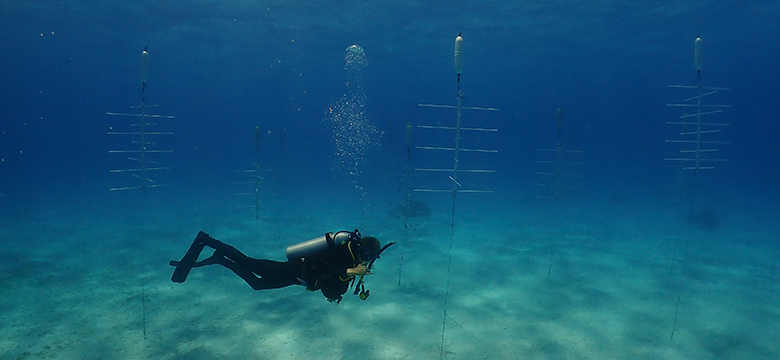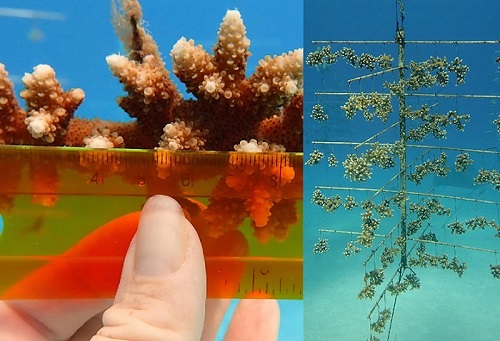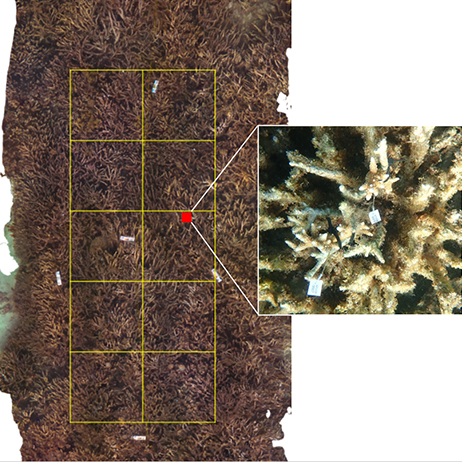- ABOUT US
- PROGRAM AREAS
- CONSERVATION APPROACH
- EDUCATION
- MULTIMEDIA
- Saipan Coral Nursery Pilot Project
- Saipan Resilience Report (2018)
- Coral Reef Condition: A Status Report for the Commonwealth of the Northern Mariana Islands (2018)
- Assessing relative resilience potential of coral reefs to inform management
- A Manager's Guide to Coral Reef Restoration Planning and Design
Coral nurseries are helping to restore coral reefs in Saipan, Commonwealth of the Northern Mariana Islands
By: Steven McKagan, NOAA Fisheries Pacific Islands Regional Office, CNMI Coral Reef Fisheries Liaison
Takeaway
While Saipan, in the Commonwealth of the Northern Mariana Islands, seems remote, the coral reefs are threatened by bleaching and crown-of-thorn starfish outbreaks. To help corals recover from past events, corals are being grown in nurseries in Saipan lagoons and then outplanted on degraded reefs.

Background
Saipan experienced coral bleaching events in 2013, 2014, and 2017 that contributed to a loss of over 60% of total coral cover based on surveys of 34 shallow reef sites (5-6m) (Maynard et 2018). Additionally, Acanthaster planci, the crown-of-thorns starfish, feeds on stony corals. While these predators are a natural part of the ecosystem, when coral cover drastically declines over a short period of time, the starfish will concentrate on the few remaining colonies, leading to further coral reef decline. The 2018 Saipan Demonstrated Resilience Study confirmed that many of Saipan's reefs have lost more than 90% of their branching corals since 2014.
To help coral populations recover from bleaching and predation, NOAA funded a pilot project that established an ocean-based coral nursery on Saipan in summer 2019. Initially, the nursery consisted of 10 “tree” structures with a capacity to house 1,000 corals. These donor colonies were survivors of a severe bleaching and mortality event in 2017 and, therefore, had demonstrated resilience to heat stress.
In order to create a coral nursery, PVC “trees” are created and anchored to the bottom of shallow sandy areas. Coral fragments are attached to each arm of the tree with a monofilament line. Divers then collected a total of 40 parent colonies from five different species in 2019. Approximately 400 fragments were transferred to the nursery with an almost 100% survival rate. Growth measurements were taken during initial collection and throughout the growing season to track growth rates.


Current Outlook
Over the last nearly five years, the nursery has grown from 10 tree structures to 23 tree structures and four tables, housing thousands of coral colonies representing 11 species, with more plans to expand in the future. Corals in the nursery are tracked and measured to provide information on growth rates and general health in the nursery and eventually on the reef. Johnston Applied Marine Sciences, who NOAA has contracted to implement the nursery project, began outplanting the coral to priority degraded reefs in 2020. JAMS will be greatly upscaling outplanting over the coming years, now that the nursery is well established.
Funding for this work was provided by NOAA's Pacific Islands Regional Office Habitat Conservation Division, Coral Reef Conservation Program, and Restoration Center. For more information, please email Steven McKagan.
Related Stories and Products
About Us

The NOAA Coral Reef Conservation Program was established in 2000 by the Coral Reef Conservation Act. Headquartered in Silver Spring, Maryland, the program is part of NOAA's Office for Coastal Management.

The Coral Reef Information System (CoRIS) is the program's information portal that provides access to NOAA coral reef data and products.
Work With US
U.S. Coral Reef Task Force
Funding Opportunities
Employment
Fellowship Program
Contracting Assistance
Graphic Identifier
Featured Stories Archive

Access the archive of featured stories here...
Feedback
Thank you for visiting NOAA’s Coral Reef Conservation Program online. Please take our website satisfaction survey. We welcome your ideas, comments, and feedback. Questions? Email coralreef@noaa.gov.
Stay Connected
Contact Us
NOAA’s Coral Reef Conservation Program
SSMC4, 10th Floor
1305 East West Highway
Silver Spring, MD 20910
coralreef@noaa.gov
